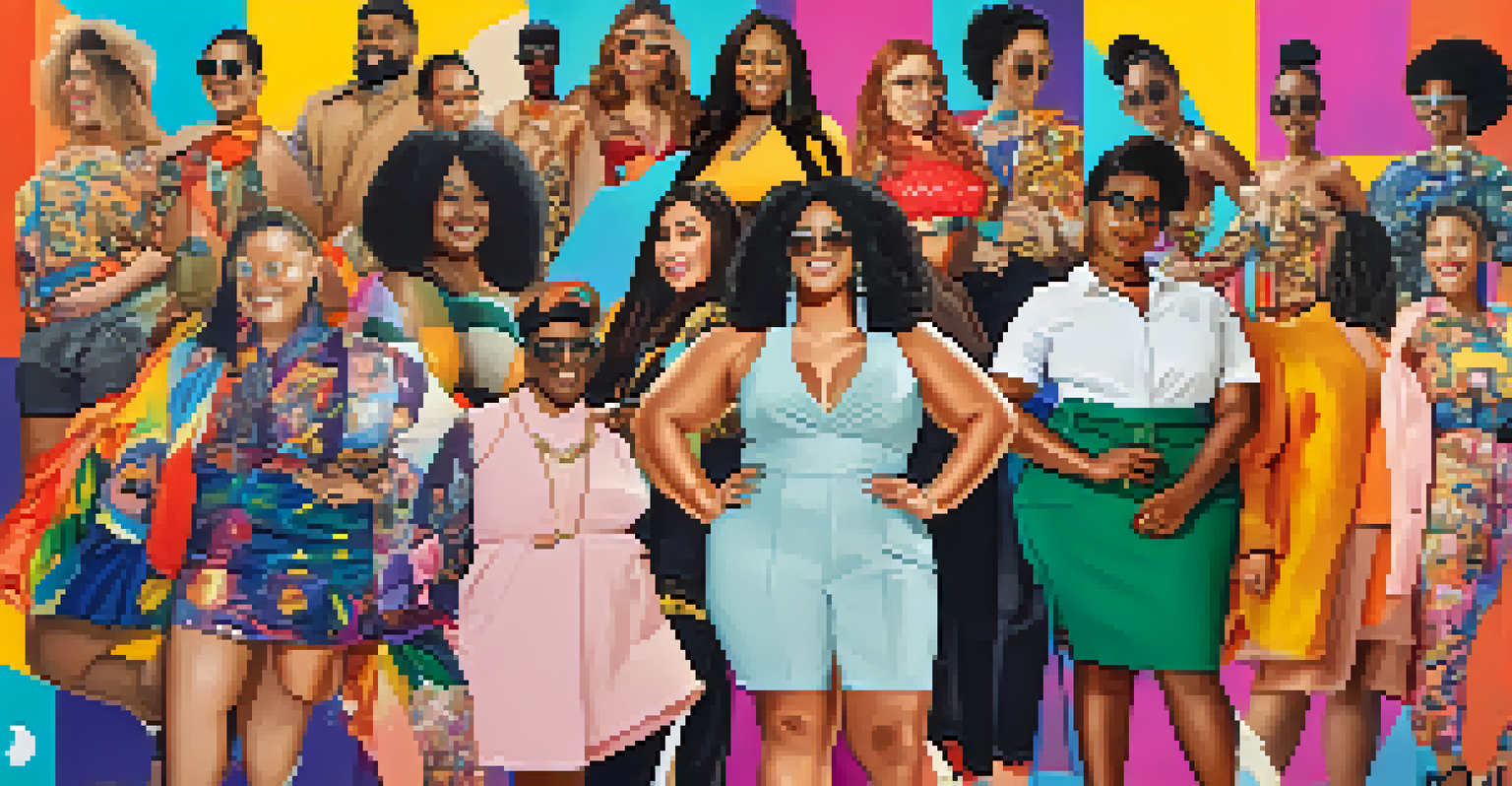The Importance of Size Diversity in Fashion Retail

Size Diversity: A Reflection of Real-World Bodies
In the world of fashion, size diversity is more than just a trend; it's a reflection of the diverse bodies that exist in society. When brands embrace a variety of sizes, they acknowledge that beauty comes in all shapes and forms. This inclusivity allows consumers to see themselves represented, fostering a sense of belonging and acceptance. Imagine walking into a store where every body type is celebrated—it’s not just liberating, but empowering too.
Fashion is about dressing according to what’s fashionable. Style is more about being yourself.
Moreover, size diversity challenges the traditional standards of beauty that have long dominated the fashion industry. By showcasing a wider range of sizes, retailers can break down the unrealistic ideals that often leave many feeling excluded. This shift not only benefits consumers, but it also encourages brands to innovate in their design and marketing strategies, ultimately leading to a more successful business model.
Incorporating size diversity into fashion retail sends a powerful message: that everyone deserves to feel good in their skin. When consumers see themselves represented in advertising and on store shelves, it builds trust and loyalty toward the brand. This deeper connection can drive repeat purchases and positive word-of-mouth, which are invaluable in today’s competitive market.
The Business Case for Size Diversity
Diversity in sizing isn't just a moral imperative; it's also a smart business move. Data shows that brands offering a wider range of sizes not only attract a broader customer base but also see increased sales. By catering to diverse body types, retailers can tap into a previously underserved market, unlocking significant revenue potential. Think of it as a win-win situation: brands get more customers, and customers get more choices.

Additionally, brands that prioritize size diversity often enjoy enhanced customer loyalty. When shoppers find their size, they are more likely to return and recommend the brand to others. This loyalty is invaluable, particularly in a world where consumers have endless options. Just like a favorite local restaurant, when people feel valued and catered to, they keep coming back for more.
Size Diversity Empowers Consumers
Embracing a variety of sizes in fashion fosters a sense of belonging and acceptance for all body types.
Moreover, size diversity can set a brand apart in a crowded marketplace. With consumers increasingly focused on inclusivity, brands that embrace a range of sizes can build a strong identity that resonates with their audience. This differentiation can lead to a competitive advantage, allowing brands to stand out and thrive in the fashion industry.
Consumer Demand for Inclusive Sizing
Today's consumers are vocal about their preferences, and one of the loudest demands is for inclusive sizing. Shoppers want to see themselves represented, and brands that ignore this demand risk being left behind. Social media has amplified these voices, making it easier for consumers to share their experiences and expectations. A single tweet or post can spark a movement, urging brands to reconsider their sizing policies.
Diversity is being invited to the party; inclusion is being asked to dance.
Furthermore, the demand for size diversity is not just a passing phase; it's a lasting shift in consumer behavior. As younger generations prioritize inclusivity and diversity, brands that adapt will thrive. This trend signifies a fundamental change in how we view fashion and body image, one that embraces authenticity over conformity.
Brands that listen to their customers and respond by expanding their size offerings are not just meeting a demand—they are building a community. When consumers feel heard and valued, they are more likely to engage with the brand and become advocates for it. This deeper relationship can drive brand loyalty that lasts well beyond a single purchase.
The Role of Retailers in Promoting Size Diversity
Retailers play a crucial role in promoting size diversity in fashion. By curating collections that feature various sizes, they can create a more inclusive shopping environment. This involves not just stocking more sizes but also ensuring that these options are visible and accessible to all customers. Imagine a store layout that celebrates diversity instead of hiding it—this can make all the difference.
Moreover, retailers can educate their staff about the importance of size diversity, ensuring they are equipped to assist a diverse clientele. Training employees to understand and appreciate body positivity can significantly enhance the shopping experience. When customers feel welcomed and understood, they are more likely to return and share their positive experiences with others.
Inclusivity Boosts Brand Loyalty
Brands that prioritize size diversity attract a broader customer base and encourage repeat purchases.
Additionally, retailers can collaborate with brands that prioritize inclusivity, thereby amplifying the message of size diversity. By advocating for more extensive size ranges in their inventory, they can lead the charge in reshaping the fashion landscape. This proactive stance not only benefits the retailers but also promotes a culture of acceptance and celebration of all body types.
Challenges in Implementing Size Diversity
While the importance of size diversity is clear, implementing it in fashion retail comes with its own set of challenges. One significant hurdle is the traditional fashion industry mindset, which often prioritizes a narrow range of sizes. Changing this mindset requires courage and commitment from brands willing to take the plunge into a more inclusive approach. It’s like trying to turn a massive ship; it takes time, but the journey is worth it.
Another challenge is the logistics of producing a wider range of sizes. This can involve rethinking supply chains, manufacturing processes, and even marketing strategies. Brands need to invest in research and development to ensure they provide quality products across all sizes. However, overcoming these hurdles can lead to a more resilient business model that resonates with modern consumers.
Lastly, there is the risk of backlash from consumers who are accustomed to traditional sizing. Brands must navigate these waters carefully, ensuring that their size inclusivity efforts are authentic and not just a marketing ploy. Transparency and honesty in these efforts can help build trust and mitigate potential criticism.
The Impact of Social Media on Size Diversity
Social media has revolutionized the way we view body image and diversity in fashion. Platforms like Instagram and TikTok have given a voice to influencers and everyday users alike, who advocate for size inclusivity. This shift has forced brands to pay attention to consumer demands and adapt their strategies accordingly. It’s akin to having a megaphone for the message of body positivity and acceptance.
Moreover, social media has created a space where diverse body types are celebrated and normalized. Users share their fashion experiences, showcasing their unique styles and encouraging others to embrace their bodies. This community-driven movement has led to increased visibility for brands that prioritize size diversity, effectively amplifying their reach and impact.
Social Media Drives Size Demand
Platforms like Instagram amplify consumer voices, urging brands to adopt inclusive sizing practices.
Brands that actively engage with these conversations on social media can foster a sense of community and belonging among their customers. By sharing stories that resonate, they can build relationships that go beyond the transactional. This connection can lead to a loyal following, as consumers feel aligned with a brand that shares their values and promotes inclusivity.
Future Trends in Size Diversity for Fashion Retail
As we look to the future, size diversity in fashion retail is poised to become even more integral. Brands are beginning to recognize that inclusivity isn’t just a trend but a fundamental aspect of modern consumer expectations. This realization will likely lead to even more innovative sizing solutions, such as custom fits or adaptive clothing for those with disabilities. Imagine a future where every body is catered to with ease and style.
Additionally, advancements in technology may play a significant role in promoting size diversity. Virtual fitting rooms and AI-driven sizing tools could help consumers find their perfect fit from the comfort of their homes. Such innovations will make online shopping more inclusive and accessible, ensuring that everyone has a chance to express their style.

Finally, as the conversation around body positivity continues to evolve, we can expect to see even more brands stepping up to the plate. This wave of change will not only reshape the fashion industry but also redefine our cultural understanding of beauty. As size diversity becomes the norm, we can look forward to a more inclusive world where fashion truly celebrates all bodies.